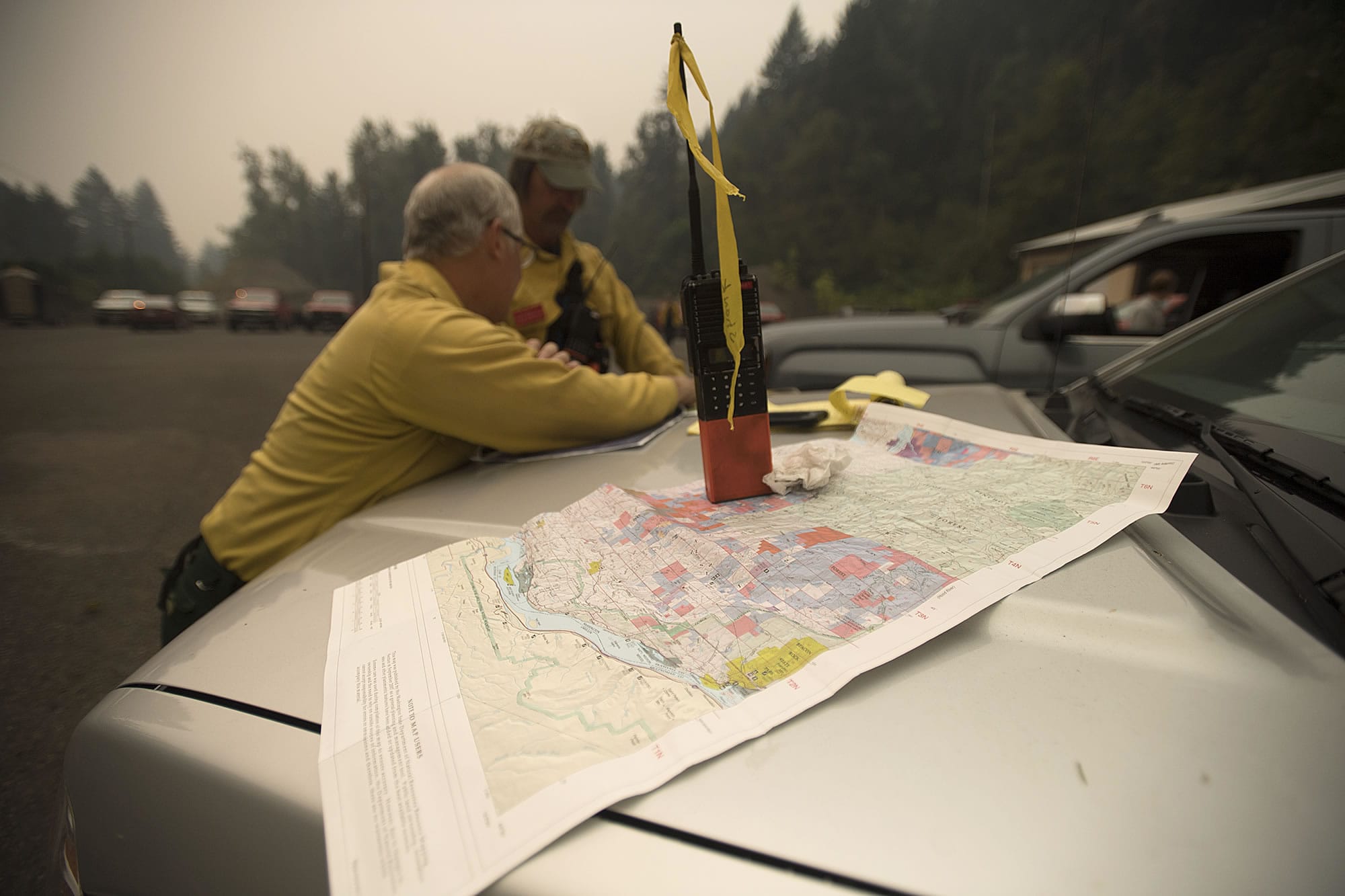Fires burning in the Columbia River Gorge are threatening infrastructure from state parks to regional transmission lines, and officials are trying to balance access with safety.
Interstate 84 in Oregon is closed due to the Eagle Creek Fire. Although state Highway 14 is still open, the Washington Department of Transportation is urging people to avoid driving through the Columbia River Gorge unless it’s necessary.
Trucks over 10,000 gross vehicle weight are prohibited from using the highway between Washougal and Dallesport.
“We’re now fighting a wildfire on this side of the river,” said WSDOT spokeswoman Tamara Greenwell. “For safety, the less vehicles that are in the area the better it is for crews to respond to the fire.”
As the Archer Mountain Fire burns less than five miles west of Beacon Rock State Park, the Washington State Parks and Recreation Commission took precautionary measures and closed the facility early Tuesday morning.
“If an ember or spark came and landed on one of the trails, (park staff) wouldn’t want to have to worry about evacuating people hiking,” said Toni Droscher, a spokeswoman for state parks.
While it may be tempting to go out and see the fires, she urged people to stay out of the Gorge if they don’t have to be there.
“I’d reiterate, what (WSDOT) said, if you don’t have to be on that section of Highway 14, stay away, avoid the area,” she said.
BNSF Railways spokesman Gus Melonas said train traffic through the Gorge was temporarily shut down Tuesday morning for track inspections through the corridor, but movements resumed as normal shortly thereafter.
“The mainline is in service. That includes all trains, all types,” he said, which includes coal and oil. “All traffic is running safely.”
The railroad has officers riding trains and instructed crews to report any abnormal situations.
BNSF averages more than 40 trains per day on the Washington side of the Columbia. Currently, however, it’s not holding trains in the Stevenson area, which is in range of the fires.
Union Pacific Railroad has temporarily suspended train traffic through the Oregon side of the Gorge due to the fires.
Justin E. Jacobs, spokesman for Union Pacific, said train traffic was suspended Tuesday morning for 24 to 48 hours, but that could change depending on conditions on the ground.
“We’re working with state and local entities in regards to what’s next,” he said.
Kevin Wingert, spokesman for the Bonneville Power Administration, said the agency is fully serving all of its utility customers, but several of its transmission lines are in close proximity to the Archer Mountain Fire in Skamania County and the Eagle Creek Fire burning just across the Columbia River in Oregon.
The BPA had deactivated just one transmission line on Tuesday, the North Bonneville-Hood River 115-kilovolt line from Acton Substation to Cascade Locks. All other lines, including two 115-kilovolt and two 230-kilovolt lines that originate from North Bonneville and move through the corridor, are in service.
“We’re monitoring those lines closely and actively studying the situation,” Wingert said.
Most of the transmission lines are on steel towers, and the lines themselves “perform well under these circumstances,” Wingert said. If a fire enters the area, the BPA can deactivate the lines until the fire subsides and turn them back on.
“That might be a matter of hours to deactivate and reactivate the lines,” he said.
However, the 115-kilovolt lines are on a mixture of steel and wood poles and thus require more monitoring.
According to a news release, the BPA is coordinating its transmission actions with U.S. Forest Service Fire Management Team 6 to de-energize and re-energize lines and facilities so fire crews can safely access and fight the wildfire while the BPA maintains a reliable transmission system.
“Our primary focus is maintaining reliability of the system as well as ensuring the safety of our maintenance crews, fire crews and emergency responders,” Wingert said.
The Oregon Department of Fish and Wildlife evacuated its staff from three hatcheries in Cascade Locks over the weekend due to the Eagle Creek Fire.
All staff from the Bonneville, Oxbow and Cascade hatcheries are accounted for and a few will return to monitor the facilities and the fish as it is safe to do so, according to a news release.
“The safety of our staff and the public is always our first priority,” Bruce Eddy, ODFW east region administrator, said in a news release.
Firefighters are using the hatcheries as a staging and firefighting areas. Crews also sprayed some of the buildings with foam to prevent them from catching fire.
So far, none have been damaged.
Fish and Wildlife is releasing some fish early to reduce demands on water supplies and equipment.
Four ponds of fall chinook, which were planned to be released in October, were released early Monday night. Also, 600,000 tule fall chinook, planned for release in March, were released Tuesday morning. Both groups were released into the Columbia River.
“Water flow to the Bonneville Hatchery was restricted by fire debris in the hatchery intakes, and there was no way to clear the intake,” Eddy said in the release. “Pumps not down for maintenance are being used to supply the facility now.”




